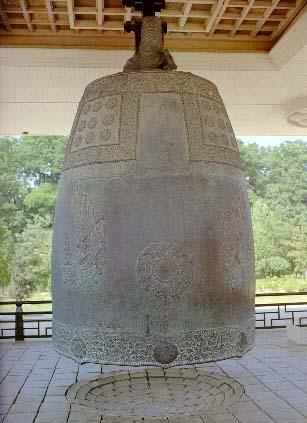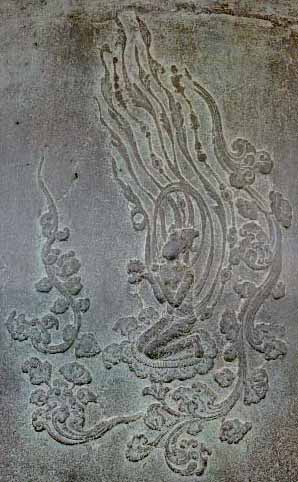

|
The
famous Emille Bell is housed in an individual pavilion in the
right yard of Kyongju
National Museum. Its official
name is the Divine
Bell of King Seongduk but it is
nicknamed after the legend that a baby girl cried for
"emille," or mommy after being putting in to the molten
bronze. It used to be stricken thirty three times at
the turn of a new year but ringing the bell is now forbidden
to protect it; unfortunately the actual bell tune with
solemn but delicate, long resonance is never to be heard
any more.
This bell is the largest Korean bell
so far preserved.
The quality and artistic devel
-opment of Korean bell making has been recognized world
-wide and must be ranked among the proudest examples
of Korea's cultural achieve -ments. The apex of this
development was reached during Silla Kingdom and the
most perfect example is this Emille
bell. The technique of making
its connecting pin has remained a mystery.
The
Emille is 10 feet
high and
7 and a half feet in diameter. (Often the dragon hook is measured which
gives an additional foot.)
Now the largest in the
world is the 20 foot Moscow bell, but the Emille bell
is one thousand years older, more beautiful and infinitely
more graceful. The strong solemn tone reputedly can
be heard as far as 40 miles on a clear crisp night.
The purpose of the hollow tube protruding from
the top is to amplify the tone. Korean bells can be
heard at unusually long distances. When the bell was
struck on the side with a wooden log on a chain the
sound would echo from the clay vessel.
|
From
this echo chamber the sound would be transmitted through
the tube at the top.
The Emille Bell embodies the characteristics
of the ancient Korean bronze bells.
Though
now we call this bell the Emille
Bell of Bongduksa, the actual
name is engraved on its surface. "Great King Sungduk's Divine Bell"
is the name inscribed though people
still refer to this bell as Emille.
Legend has
it that it could ring by throwing the artisan's beloved
little daughter into the melted bronze as a sacrifice
after numerous repeated failures. From then on, the
bell has sounded like a baby crying for its mother,
and that's why it's called the Emille bell
|